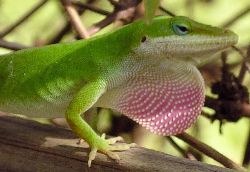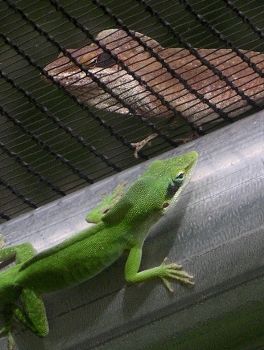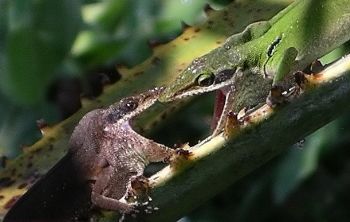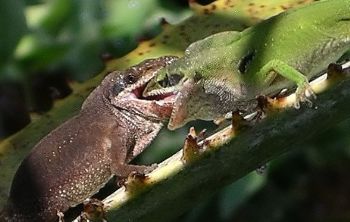November, 2008
When Push Comes to Shove
by Valerie
Probably anyone who has lived here in Austin, TX, has at one time or another noticed the green anoles. They live just about anywhere there is vegetation, including parks, greenbelts, gardens, and yards. These arboreal little lizards are well adapted for their habitat, able to scamper around on everything from the sides of houses to tree bark to agave thorns. They are very active during warm weather and, although their color can camouflage them, their locations are often revealed when they move.
 Anoles are sometimes called chameleons, even though they are not related to the African lizards of that name. The reason for this misnomer is the anoles' ability to change color. They can shift from green to brown in a matter of seconds. There are several factors which might produce one color or another, including temperature, background hues, and emotional state. The temperature and background prompts are understandable enough; a cold dark brown lizard will absorb heat faster than a light green one, and green is better for hiding in leaves while brown is more suitable for branches. However, the idea that reptiles can be emotional sounds a bit fanciful.
Anoles are sometimes called chameleons, even though they are not related to the African lizards of that name. The reason for this misnomer is the anoles' ability to change color. They can shift from green to brown in a matter of seconds. There are several factors which might produce one color or another, including temperature, background hues, and emotional state. The temperature and background prompts are understandable enough; a cold dark brown lizard will absorb heat faster than a light green one, and green is better for hiding in leaves while brown is more suitable for branches. However, the idea that reptiles can be emotional sounds a bit fanciful.
Compared to most other snakes and lizards, anoles have personality plus, and watching their antics is always worth taking a bit of time from other outdoor occupations. They actively hunt insects, leaping about like little cats after rodents. They can also be seen shedding their skin (which they pull off and eat), basking in the sun, coming to water for drinks, and mating. This last activity is the impetus for a number of entertaining behaviors, mostly provided by the males.
While females are occasionally aggressive towards one another, they more often simply feed and sun themselves with little regard for the neighbors. The males, however, have the job of maintaining territories. A good territory, from what I can glean after seeing where the males tend to be most belligerent, includes plenty of leafy cover, good places to bask in the sun, and flowers or something similar to attract lots of prey.
Male anoles will respond in various ways to other members of their species. When females are around, they often extend their throat dewlap, as if to show off. At the same time they will bob up and down, similar to doing push-ups. This same behavior is used as a warning to possible intruders of unknown threat level. We humans fit into this category. Very brave anoles will boldly display, while those that are a bit more timid will give a few dewlap flashes and then hide. When males encounter each other, though, things are different.
A mature male encountering an immature one is no contest. The younger and smaller lizard might act brazen in front of females when he thinks he can get away with it, but the moment he realizes a resident dominant male has seen him, it is time to turn duller green or even brown and run away. Sometimes the chases go on for awhile, with the big male driving the younger one as far as possible from his territory.
There are times when well-matched males meet, and then things get nasty. They start with the dewlap display, but then they also raise a crest on the back of their necks (presumably to look bigger). And then they fight. The first time I saw this was in our compost bins, a very desirable anole habitat. I came across a pair of lizards with their jaws locked on each others heads. The one on top was actually holding up the other as he hung down below. At first I thought the upper one had the advantage, but the colors were wrong. The upper one was brown while the lower one was green. It is usually expected that the one who is winning will be the bright green while the loser will be brown. Then I carefully noted just how they had their jaws locked. The lower "winning" one had his mouth completely over his rival's head on both sides, while the upper one could not really get a good grip because the angle forced his lower jaw to hang open ineffectively. As soon as the lower one released his grip and fell down a bit, he leapt back up and chased off the brown lizard. There were actually injuries visible on the head of the loser!
Since that time, I've seen several other encounters between males. One of the funniest occurred on the roof of an enclosed butterfly flight house at a farm called Wild-Connections. The screening was fine enough that neither lizard could get through to attack the other, but that didn't stop them from posturing and gesturing back and forth for several minutes. Again, as with the pair in the compost bin, the one who was on the upper side, and even bigger in size, was brown, while the smaller one inside was green. In human perception, this would appear to be backwards. However, the one on the INSIDE of the flight house had the prime territory, including lots of well-watered foliage and flowers filled with insects and spiders. The outsider had not found a way in yet, but that didn't stop him from being jealous and frustrated, and therefore responding in the prescribed manner.
Sometimes, two male anoles look equally matched, at least to my uninformed mammalian eye. This was the case with the pair in the final photos here. Watching these two fight was like seeing a miniature version of those old dinosaur movies. They ferociously opened their jaws and lunged back and forth, finally locking jaws and wrestling for quite some time. Eventually the brown one pulled away and ran off, with the green one in hot pursuit.


Although their small size makes them seem less noteworthy than, say, battling bull elks in the Rocky Mountains, it is hard to beat these little reptiles for an exciting up close and personal encounter with the wild kingdom.
 Anoles are sometimes called chameleons, even though they are not related to the African lizards of that name. The reason for this misnomer is the anoles' ability to change color. They can shift from green to brown in a matter of seconds. There are several factors which might produce one color or another, including temperature, background hues, and emotional state. The temperature and background prompts are understandable enough; a cold dark brown lizard will absorb heat faster than a light green one, and green is better for hiding in leaves while brown is more suitable for branches. However, the idea that reptiles can be emotional sounds a bit fanciful.
Anoles are sometimes called chameleons, even though they are not related to the African lizards of that name. The reason for this misnomer is the anoles' ability to change color. They can shift from green to brown in a matter of seconds. There are several factors which might produce one color or another, including temperature, background hues, and emotional state. The temperature and background prompts are understandable enough; a cold dark brown lizard will absorb heat faster than a light green one, and green is better for hiding in leaves while brown is more suitable for branches. However, the idea that reptiles can be emotional sounds a bit fanciful.


